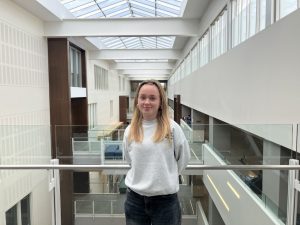West wing strives for eco-friendly design
Eco-friendly architecture and green design of building benefits both environment and students
November 3, 2017
Not only has the addition to New Trier’s Winnetka campus brought a host of modern features, such as a new library and a revamped cafeteria, but it also facilitates an initiative to make the building more energy-efficient and environmentally aware.
One of the newest additions was two green roofs on the fourth floor — complete with their own gardens — that are inspired by the desire to feel connected to nature. Coupled with the skylights spanning the ceiling, the countless glass windows on the walls, and the open, free atmosphere, the entire West Wing building radiates an environmentally conscious vibe.
“There are a lot of windows and a lot of natural light,” said senior Jack Mersino, who is an architecture student and learned about green construction in his previous classes.
Senior Tara O’Connor, also an architecture student, also agreed with the choice of ample natural light, adding that the new building provides far more insulation as well.
Another principle of green design is making sure the building is not harmful to the people inside. This can be ensured by using fewer toxic chemicals during construction, especially in paint. The new addition utilizes water-based paints and materials that are as sustainable and long-lasting as the building itself, according to architecture teacher Jason Boumstein.
A significant part of eco-friendly architecture also involves the idea of accessibility, specifically ADA-compliant features like wider doorways and bathrooms. Features like these are present in various places in the building, including two new elevators and more ramps on the lower floors of the building, said the New Trier website.
Not only does the new addition have environmentally friendly features, but part of it includes making the building more “clean” and efficient with energy consumption.
The New Trier Anew event page explains that the district is seeking a LEED Silver Certification or higher. LEED, or Leadership in Energy and Environmental Design, is a global green building rating system based on several criteria, such as air quality and energy use.
“LEED certification has two main purposes: to create a better world and reduce the carbon footprint,” said Boumstein. “LEED is the number one used award to communicate that a building effectively reduces energy, water usage, implements a process for recycling, and so on. Points are given for different criteria matched.”
The number of points earned correlates with a specific kind of certification. The options include LEED Certified, Silver, Gold and Platinum, of which Platinum is the highest ranking. New Trier is aiming for a Gold rating, according to Boumstein.
The new addition’s environmental awareness is not only aimed at helping the earth, but the students as well. Research has shown that being outside can drastically improve mood and academic performance levels, according to junior Leah Ulrich, who wrote an extensive essay concerning the topic for her AP Language & Composition class.
“Spending more time outside – for example, eating outside or even just taking one walk a day – can greatly decrease stress,” said Ulrich. “Even just having natural scenery, like a picture of nature in your room or natural background noises, can really help you focus on your work.”
Ulrich’s essay research suggests that being in certain areas of the new building, like the green roofs or in the concourse, can have a positive influence on students’ productivity.
“I often study outside. Being in nature helps calm me,” explained Ulrich.
With eco-friendly design, however, comes quite a price tag that requires investment; the initial costs of making a building environmentally aware can be higher than a building that’s not energy-efficient. It can even cost money to get a LEED certification, according to the United States Green Building Council.
With patience, however, green construction can bring more benefits than drawbacks. “When you’re looking for energy efficiency, you have to plan for it. Usually, the upfront costs are greater, but the long-term payback is more beneficial,” said Boumstein.
Despite the costs, it seems that students are enjoying the new building and all of the features that is has to offer.
“I’ve been up to the green roofs, and it’s a great place to eat lunch and interact with people,” said Ulrich.
Boumstein echoed these positive sentiments. He said, “It is exciting to hear that New Trier’s new wing is going for a gold level.”










































